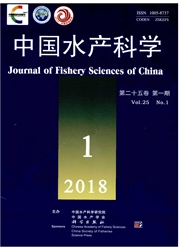

 中文摘要:
中文摘要:
采用实验生态学方法研究了不同质量浓度Hg~(2+)和Pb~(2+)胁迫对脆江蓠(Gracilaria chouae)生长及光合生理的影响。实验设置Hg~(2+)质量浓度为0.01 mg/L、0.025 mg/L、0.05 mg/L、0.1 mg/L、0.25 mg/L和0.5 mg/L,Pb~(2+)质量浓度为0.05 mg/L、0.1 mg/L、0.5 mg/L、1 mg/L、2 mg/L和4 mg/L,以未添加重金属的实验组为对照,持续培养7 d,分别测定不同处理藻体的生长速率、光合放氧速率、光合色素含量、叶绿素荧光和光合碳代谢途径中关键酶活等生理生化指标。结果表明,在Hg~(2+)胁迫下,藻体特定生长率(SGR)显著下降(P〈0.05),质量浓度达到0.5 mg/L时藻体出现负增长;光合放氧速率降低35.48%~77.59%;叶绿素a、类胡萝卜素含量显著下降(P〈0.05),Hg~(2+)质量浓度高于0.1 mg/L时藻体藻蓝蛋白和藻红蛋白含量显著降低(P〈0.05);最大光合效率(F_v/F_m)和实际光合效率(Y(Ⅱ))随着Hg~(2+)浓度增加先降低后升高,0.05 mg/L时出现第二个峰值,丙酮酸磷酸双激酶(PPDK)也出现相似趋势。藻体对Pb~(2+)的敏感程度低于Hg~(2+),Pb~(2+)质量浓度为0.5 mg/L时,光合产氧速率显著下降(P〈0.05),质量浓度到达1 mg/L时,藻体SGR和叶绿素a、类胡萝卜素出现显著下降(P〈0.05),而叶绿素荧光参数和藻蓝蛋白含量则无显著性差异;Pb~(2+)质量浓度达到4 mg/L时1,5-二磷酸核酮糖羧化酶(RuBiSCO)出现显著下降(P〈0.05),PPDK酶活性则显著上升(P〈0.05)。实验结果证实:重金属Hg~(2+)和Pb~(2+)胁迫对脆江蓠的生长和光合作用都有不利影响,藻体对Hg~(2+)胁迫的敏感度要高于Pb~(2+),Hg~(2+)质量浓度为0.01 mg/L时,藻体出现胁迫,并随着浓度的增加而加剧,Pb~(2+)质量浓度超过1 mg/L时,藻体胁迫明显。
 英文摘要:
英文摘要:
In this study, we investigated the impact of Hg2+ and Pb2+ on the growth and photosynthetic physiologi- cal characteristics of Gracilaria chouae by exposing algal thalli to five concentrations of HgC12 (0.01 mg/L, 0.025 mg/L, 0.05 mg/L, 0.1 mg/L, 0.25 mg/L, and 0.5 mg/L) and PbC12 (0.05 mg/L, 0.1 mg/L, 0.5 mg/L, 1.0 mg/L, 2.0 mg/L, and 4.0 mg/L); the reference group expoged to seawater without Hg2+ and Pb2+. The growth rate, photosynthetic rate, pigment content, Chlorophyll II fluorescence characteristics, and the activity of RuBisCO and PPDK in the thalli were measured after 7 days of incubation. The special growth rate (SGR) reduced significantly as the Hg2~ level increased (P〈0.05), mortality was observed following incubation with the highest concentration of Hg2+, and the photosynthetic rate reduced by 35.48%-77.50%. Similar trends were also observed for chlorophyll a (Chla) and carotenoid (Car) levels (P〈0.05). Phycoerythrin (PE) and phycocyanin (PC) content was significantly lower at Hg2+ levels above 0.1 mg/L (P〈0.05). The trend of the variation of Fv/Fm and Y( II ) with Hg2+ concentration was close to a bimodal curve, and the second peak appeared at 0.05 mg/L;PPDK activity showed a similar trend. The specific growth rate and Chla and Car content was significantly lower at Pb2+ levels above 1 mg/L (P〈0.05). However, no significant change in either chlorophyll II fluorescence characteristics or the level in PC content was found among different Pb2+ levels. Significantly lower RuBisCO activity was found at the highest pb2+concentration than at lower concentrations, while PPDK activity was significantly higher (P〈0.05). In con- clusion, Hg2+ and Pb2+ both showed detrimental effects on the growth and photosynthesis of G chouae; however, this alga is more susceptible to Hg2+. A stress response was observed after the Hg2+concentration reached 0.01 mg/L, and this response increased as Hg2+concentration increased, while no
 同期刊论文项目
同期刊论文项目
 同项目期刊论文
同项目期刊论文
 期刊信息
期刊信息
